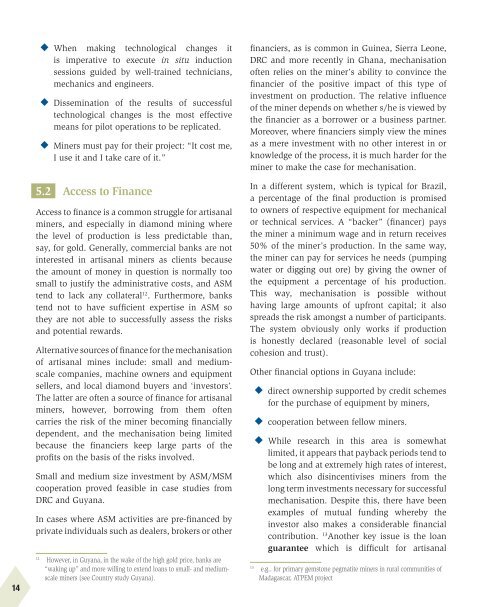Mechanisation-Alluvial-Artisanal-Diamond-Mining
Mechanisation-Alluvial-Artisanal-Diamond-Mining
Mechanisation-Alluvial-Artisanal-Diamond-Mining
- No tags were found...
You also want an ePaper? Increase the reach of your titles
YUMPU automatically turns print PDFs into web optimized ePapers that Google loves.
14◆◆When making technological changes itis imperative to execute in situ inductionsessions guided by well-trained technicians,mechanics and engineers.◆◆Dissemination of the results of successfultechnological changes is the most effectivemeans for pilot operations to be replicated.◆◆Miners must pay for their project: “It cost me,I use it and I take care of it.”5.2 Access to FinanceAccess to finance is a common struggle for artisanalminers, and especially in diamond mining wherethe level of production is less predictable than,say, for gold. Generally, commercial banks are notinterested in artisanal miners as clients becausethe amount of money in question is normally toosmall to justify the administrative costs, and ASMtend to lack any collateral 12 . Furthermore, bankstend not to have sufficient expertise in ASM sothey are not able to successfully assess the risksand potential rewards.Alternative sources of finance for the mechanisationof artisanal mines include: small and mediumscalecompanies, machine owners and equipmentsellers, and local diamond buyers and ‘investors’.The latter are often a source of finance for artisanalminers, however, borrowing from them oftencarries the risk of the miner becoming financiallydependent, and the mechanisation being limitedbecause the financiers keep large parts of theprofits on the basis of the risks involved.Small and medium size investment by ASM/MSMcooperation proved feasible in case studies fromDRC and Guyana.In cases where ASM activities are pre-financed byprivate individuals such as dealers, brokers or other12However, in Guyana, in the wake of the high gold price, banks are“waking up” and more willing to extend loans to small- and mediumscaleminers (see Country study Guyana).financiers, as is common in Guinea, Sierra Leone,DRC and more recently in Ghana, mechanisationoften relies on the miner’s ability to convince thefinancier of the positive impact of this type ofinvestment on production. The relative influenceof the miner depends on whether s/he is viewed bythe financier as a borrower or a business partner.Moreover, where financiers simply view the minesas a mere investment with no other interest in orknowledge of the process, it is much harder for theminer to make the case for mechanisation.In a different system, which is typical for Brazil,a percentage of the final production is promisedto owners of respective equipment for mechanicalor technical services. A “backer” (financer) paysthe miner a minimum wage and in return receives50% of the miner’s production. In the same way,the miner can pay for services he needs (pumpingwater or digging out ore) by giving the owner ofthe equipment a percentage of his production.This way, mechanisation is possible withouthaving large amounts of upfront capital; it alsospreads the risk amongst a number of participants.The system obviously only works if productionis honestly declared (reasonable level of socialcohesion and trust).Other financial options in Guyana include:◆◆direct ownership supported by credit schemesfor the purchase of equipment by miners,◆◆cooperation between fellow miners.◆◆While research in this area is somewhatlimited, it appears that payback periods tend tobe long and at extremely high rates of interest,which also disincentivises miners from thelong term investments necessary for successfulmechanisation. Despite this, there have beenexamples of mutual funding whereby theinvestor also makes a considerable financialcontribution. 13 Another key issue is the loanguarantee which is difficult for artisanal13e.g.. for primary gemstone pegmatite miners in rural communities ofMadagascar, ATPEM project



